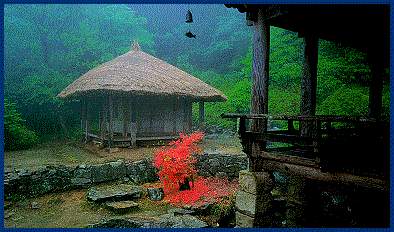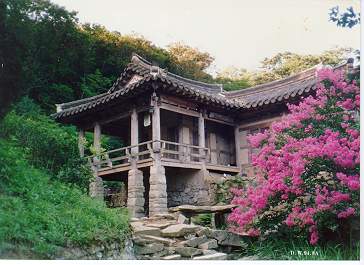...previous
page
Tea in Korea and Japan
In Korea, the drinking of tea seems to
have been introduced in the sixth or seventh centuries, probably
by Buddhist monks returning from China, where the many
schools of Buddhism attracted some of Korea's finest scholars.
There are reports in the early chronicle-histories known as Samkuk-yusa
and Samkuk-sagi that Queen Sondok of Silla (ruled
632-47) drank tea and that King Munmu in 661 ordered tea
to be used during ceremonial offerings; King Sinmun advocated
the use of tea in order to purify the mind, while King Heundok
is reported to have obtained tea seeds from Tang China for
planting in 828, but these may not have been the first.
In Japan the first record of brick
tea being used dates from around 593, and the first
planting of seeds is said to have occurred in 805. The
modern history of tea in Japan is said to have originated with
the monk Eisai (1141-1215), who introduced the Rinzai
Zen tradition to Japan. He brought tea with him upon his return
from study in China. He also wrote a treatise called the Kissa
Yojoki, which extolled the properties of tea in promoting
both physical and spiritual health. Eisai's interest in tea was
shared by his renowned disciple Dogen (1200-53), the
patriarch of the Soto sect of Zen Buddhism in Japan. When Dogen
returned from China in 1227, he brought with him many tea
utensils, and gave instructions for tea ceremonies in the rules
which he drew up for regulating daily life at Eiheiji, the
temple founded by him. Eisai is reported to have brought back
tea seeds which were the origin of most of the tea planted
subsequently across Japan as the fashion for tea-drinking spread
among social classes not previously touched by it. This grew
into the tea ceremony practiced by the samurai during
the Shogunate period..
During the Korean Goryeo Dynasty (in
the 10th -13th centuries) tea was made the subject of some of
Korea's oldest recorded poems. Tea was long offered in
the ancestral ceremonies, which are still known as Ch'a-rye
although tea has not been offered in them for centuries.
Likewise there were regular ceremonies known as Hon-ta
in which cups of green tea were offered before the statues of
the Buddha in the temples.
Why is Korea not well
known for its tea culture?
The culture of tea was so deeply identified
with Buddhism that when Buddhism was replaced by Confucianism as
the main official religious tradition at the end of the Goryeo
dynasty in the 14th century, the Buddhist way of
drinking tea was repressed at the same time as most temples were
destroyed and many monks returned to civilian life. It may have
continued weakly at the start of the new Joseon Dynasty,
for in the royal palaces a special department remained
responsible for tea. However, the first great celebration of tea
by a Korean, the Ch'aBu,
Rhapsody to Tea, written in the 1490s by the
young scholar Yi Mok (1471 - 1498), who was executed in
the 1498 Muo purge, never mentions Korean tea. It is a splendid
text, and has earned its author the title of "Father of Korean
Tea," but it is entirely devoted to Chinese tea in its lists of
names of tea-producing regions and names of teas. We find
several indications that tea was no longer known among the
ruling classes early in the Joseon period.
In the 1590s the Japanese invaded Korea and
forced hundreds of the best Korean potters to go and work in
Japan. Many of the finest bowls used in Japanese tea ceremonies
were made in Korea or were produced in Japan by potters of
Korean descent. The Korean forms of tea ceremony, of tea
equipment, and of simple building style for tea-rooms, are
probably the origin of the entire Japanese tea tradition. This
is a fact that is well-known in Korea and, like so many other
aspects of Japan's cultural debt to Korea, has been
systematically denied by Japanese 'historians' intent on
creating a purely Japanese pedigree for everything Japanese.
 After this disaster, when virtually
every significant building in Korea--palaces, temples, local
administrative compounds--was burned by the Japanese invaders,
tea culture continued to be moribund. Late in the 18th century
we find a couple of texts that mention tea, saying that nobody
in Korea drinks it or even knows what plant it is when they see
it. Then in the early 19th century we find the great scholar Dasan,
Jeong Yak-yong (1762-1836), drinking tea for his health
during his exile in Gangjin, in the far south-west of the
country. He developed a method of making caked tea. He first
obtained tea leaves after meeting a monk, the Venerable Hyejang,
at the Baengnyeon-sa temple in Gangjin. In 1809, a young
Buddhist monk, Cho-ui (1786-1866), visited Dasan, stayed
several months studying with him, and must have drunk tea with
him. Known as the great restorer of the Way of Tea in Korea,
Ch'o-ui later built the hermitage known as Ilji-am (one-branch
hermitage) above the temple now called Taehung-sa near Haenam,
in the far south of Korea, and lived there for many years. He
began to make caked tea in the Dasan manner in about 1828.
During his visit to Seoul in 1830, he gave presents of caked tea
to a number of scholars who responded with great enthusiasm to
this new drink. He brought tea to his friend the great scholar
and calligrapher Kim Jeong-hui during his exile in Jeju Island
during the 1840s.
After this disaster, when virtually
every significant building in Korea--palaces, temples, local
administrative compounds--was burned by the Japanese invaders,
tea culture continued to be moribund. Late in the 18th century
we find a couple of texts that mention tea, saying that nobody
in Korea drinks it or even knows what plant it is when they see
it. Then in the early 19th century we find the great scholar Dasan,
Jeong Yak-yong (1762-1836), drinking tea for his health
during his exile in Gangjin, in the far south-west of the
country. He developed a method of making caked tea. He first
obtained tea leaves after meeting a monk, the Venerable Hyejang,
at the Baengnyeon-sa temple in Gangjin. In 1809, a young
Buddhist monk, Cho-ui (1786-1866), visited Dasan, stayed
several months studying with him, and must have drunk tea with
him. Known as the great restorer of the Way of Tea in Korea,
Ch'o-ui later built the hermitage known as Ilji-am (one-branch
hermitage) above the temple now called Taehung-sa near Haenam,
in the far south of Korea, and lived there for many years. He
began to make caked tea in the Dasan manner in about 1828.
During his visit to Seoul in 1830, he gave presents of caked tea
to a number of scholars who responded with great enthusiasm to
this new drink. He brought tea to his friend the great scholar
and calligrapher Kim Jeong-hui during his exile in Jeju Island
during the 1840s.

The tea-room and hermitage now visible at
Ilji-am (above and below) are modern reconstructions. In 1836,
the year of Tasan's death, Ch'o-ii composed the Dongdasong,
a great poem in celebration of tea. (See: our book,
Korean Tea Classics. Read
the basic text of the poem in our translation) He also
wrote other poems that mention tea, some of which have been
translated into English by the Ven. Jinwol and are available here. Click here for more pictures of places
associated with the Ven. Cho-ui

Yet despite the example of Cho-ui, the Way of
Tea remained almost unknown in Korea, even among monks, until
its restoration in the course of recent decades, a restoration
due in large part to the efforts of the Venerable HyoDang,
Choi Beom-sul. He might be considered to be the "Cho-ui of
the 20th century," for he wrote the first full length study of
tea to be published in modern Korea and taught many people about
the various aspects of tea. He was active in the Korean
Independence Movement, and founded several schools and a
university after 1945, as well as being the teacher of virtually
all the leading figures in the modern Korean tea revival. His
way of making Panyaro tea, continued by Chae Won-Hwa, is
described in the following pages.
Click to go on to the next
page or back to the Index
 After this disaster, when virtually
every significant building in Korea--palaces, temples, local
administrative compounds--was burned by the Japanese invaders,
tea culture continued to be moribund. Late in the 18th century
we find a couple of texts that mention tea, saying that nobody
in Korea drinks it or even knows what plant it is when they see
it. Then in the early 19th century we find the great scholar Dasan,
Jeong Yak-yong (1762-1836), drinking tea for his health
during his exile in Gangjin, in the far south-west of the
country. He developed a method of making caked tea. He first
obtained tea leaves after meeting a monk, the Venerable Hyejang,
at the Baengnyeon-sa temple in Gangjin. In 1809, a young
Buddhist monk, Cho-ui (1786-1866), visited Dasan, stayed
several months studying with him, and must have drunk tea with
him. Known as the great restorer of the Way of Tea in Korea,
Ch'o-ui later built the hermitage known as Ilji-am (one-branch
hermitage) above the temple now called Taehung-sa near Haenam,
in the far south of Korea, and lived there for many years. He
began to make caked tea in the Dasan manner in about 1828.
During his visit to Seoul in 1830, he gave presents of caked tea
to a number of scholars who responded with great enthusiasm to
this new drink. He brought tea to his friend the great scholar
and calligrapher Kim Jeong-hui during his exile in Jeju Island
during the 1840s.
After this disaster, when virtually
every significant building in Korea--palaces, temples, local
administrative compounds--was burned by the Japanese invaders,
tea culture continued to be moribund. Late in the 18th century
we find a couple of texts that mention tea, saying that nobody
in Korea drinks it or even knows what plant it is when they see
it. Then in the early 19th century we find the great scholar Dasan,
Jeong Yak-yong (1762-1836), drinking tea for his health
during his exile in Gangjin, in the far south-west of the
country. He developed a method of making caked tea. He first
obtained tea leaves after meeting a monk, the Venerable Hyejang,
at the Baengnyeon-sa temple in Gangjin. In 1809, a young
Buddhist monk, Cho-ui (1786-1866), visited Dasan, stayed
several months studying with him, and must have drunk tea with
him. Known as the great restorer of the Way of Tea in Korea,
Ch'o-ui later built the hermitage known as Ilji-am (one-branch
hermitage) above the temple now called Taehung-sa near Haenam,
in the far south of Korea, and lived there for many years. He
began to make caked tea in the Dasan manner in about 1828.
During his visit to Seoul in 1830, he gave presents of caked tea
to a number of scholars who responded with great enthusiasm to
this new drink. He brought tea to his friend the great scholar
and calligrapher Kim Jeong-hui during his exile in Jeju Island
during the 1840s.
